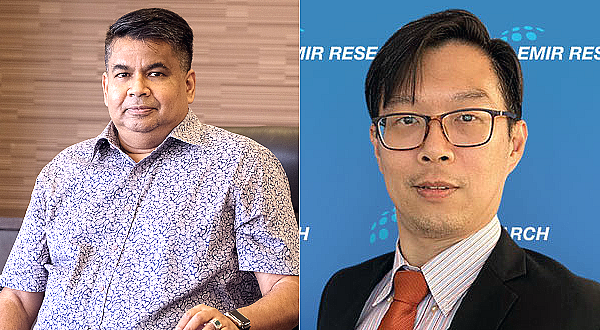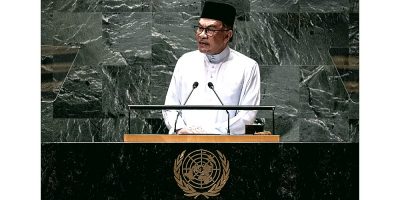
In an EMIR Research article, “Testing for reopening – simultaneous containment and controlled reopening” (July 23), we had called for the regulatory incentive for reopening of (“non-essential”) sectors and sub-sectors conditioned on testing. In turn, this article builds upon a preceding article that called for “Combining full and targeted lockdowns – in tandem” (July 15) for the (“essential”) industries (manufacturing and construction).
This testing strategy was to be conducted in tandem with the vaccination strategy so that the momentum of both can be synchronized and mutually reinforcing.
The decision by the Minister of Domestic Trade & Consumer Affairs (KPDNHEP) YB Datuk Seri Alexander Nanta Linggi to make it mandatory for all retail workers to be vaccinated as pre-condition for the full reopening and resumption of the sector reflects such a coordinated strategy under the National Recovery Plan/NRP (“KPDNHEP to make vaccination mandatory for all retail workers”, Astro Awani, July 28).
The Minister has said that the ministry was “looking into expanding the industrial vaccination centers (PPVIN) for the retail industry vaccination program (Rivac) outside the Klang Valley, especially in Johor and Penang, in the near future”. Rivac also played a part in contributing to the successful conclusion of Operation Surge Capacity which ended on August 1 with 96.7 per cent of all adults in the Klang Valley having been vaccinated with at least one dose.
The ramping up and acceleration of Rivac resonates with the earlier call by the retail and associated sectors on July 25 for fully vaccinated people to be allowed to shop at retail outlets and malls which “will help improve the chances for business survival”.
In a joint statement, the Malaysia Shopping Malls Association (MSMA), Malaysia Retailers Association (MRA), Malaysia Retail Chain Association (MRCA), Bumiputera Retailers Organization (BRO), Malaysia REIT Managers Association (MRMA), and Malaysian Association of Theme Park and Family Attractions (Matfa) also urged that shops could open for business so long as 70% public-facing staff are fully vaccinated.
Now, moving on from regulatory incentive to focusing now on fiscal incentive (financial & tax) – for both “essential” and “non-essential” sectors and sub-sectors.
The focus here, therefore, is on the supply-side equation – in addition to the pre-existing policies under the government’s aid and stimulus packages, i.e., Pemulih, Pemerkasa Plus, Pemerkasa, etc.
Examples under the latest package of Pemulih for businesses include:
– RM150 million allocation for the Public-Private Partnership Immunization Program (Pikas);
– Extension of electricity bill discounts for affected economic sectors for another three months (10% discounts for October to December);
– Removal of the RM4,000 limit for the Wage Subsidy Program (PSU 4.0) of RM600 per worker for four months as well as supporting up to 500 workers per employer;
– Additional RM100 million under the Digitization Grant for Small & Medium-Sized Enterprises/SMEs and Micro-SMEs to receive matching grants of up to RM5,000 for purchase or subscription of digital systems;
– Government procurement procedures to be eased alongside variation of price to be allowed for projects affected by higher building materials cost; and
– Syarikat Jaminan Pembiayaan Perniagaan Bhd (SJPP)’s government guarantee scheme limit to be increased by RM20 billion.
However, Pemulih and the prior aid and stimulus packages aren’t exactly a repeat of the industry wish-list.
What the businesses need also are as, e.g., articulated by Industries Unite Coordinator Datuk Irwin Cheong who have called for:
– Automatic loan moratoriums for all businesses;
– A 50% reduction in utility (electricity, water) bills for commercial rates; and
– A six-month deferment of statutory obligations such as Employers Provident Fund (EPF) and Social Welfare Organization (Socso) contributions.
And whilst Pemulih extends the existing measure initiated on rental relief under Permai and continued under Pemerkasa of tax deduction for landlords that provide at least a 30% reduction in rental for MSME tenants until December 31, the benefits have been uneven and not impactful enough.
In a study done by the Klang Parliamentary Office of YB Charles Santiago, rentals constitute a critical one-third or 35% of operating expenses. The study revealed that only about 28% of surveyed SMEs out of a total sample comprising 1,196 SMEs received a 30% reduction from their landlords versus 51% of those who did not receive anything and the remaining 21% of those who did not know about the existing scheme.
EMIR Research in “Pemulih is a welcome stimulus, but recovery may require more” (June 30) has called on the government to emulate Singapore under its COVID-19 (Temporary Measures) (Rental and Related Measures) Regulations 2020 which mandates equitable co-sharing of rental obligations between the government, landlords and tenants.
Another critical component in business costs, especially in relation to the industries is electricity. In “Decentralizing development and utility cost key to rejuvenating the economy” (Focus Malaysia, 24 July) infrastructure policy analyst and environmental activist Sharan Raj makes the salient point that electricity is “the third most important input for industries after labor force and raw materials”. In addition to rental relief, significant utility discount is critical for businesses to stay open and continue operations if they’re allowed to or reopen with a potentially better cash flow situation with knock-on effect on employment.
Tax incentives encompass corporate tax (federal), quit rent/land tax (state) and assessment rate (local).
In terms of corporate tax, there should be tax cuts from the current 24% to 18% with the pre-existing schedule for the “marginal rate” (i.e., the next amount taxable out of the total amount) intact in relation to the preferential tax rate for SMEs – which is 17% for the first RM600,000 payable and 24% on the subsequent balance – for two years (fiscal, i.e., assessment, years of 2021 and 2022).
Otherwise, a bolder measure in the form of total tax exemption for two years (fiscal, i.e., assessment, years of 2021 and 2022).
As for assessment rates, companies that have fully complied with the standard operating procedures (SOPs) and verified by audit should be entitled to rebates or discounts from the proceeds of the fines collected by the local government.
As regards quit rent, the state land and mines office could waive payments for all business and commercial owners for up to two years or provide up to 50% discount by way of opt-in or applications.
Finally, there should be what’s known as a “bankruptcy/insolvency moratorium” analogous to the loan moratorium, i.e., to prevent businesses from folding-up. This could be viewed as a logical extension of the redefinition of “bankruptcy” based on the debt ceiling/threshold as provided for under the Insolvency (Amendment) Act 2020. Section 5(1)(a) of the Act now increases the threshold of insolvency from RM50,000 to RM100,000.
In view of the prolonged lockdown and the continuing economic uncertainty, a bankruptcy/insolvency moratorium of up to one year should be immediately implemented as this shouldn’t require legislative procedure. And where applicable, an automatic blanket suspension of or exemption from “judicial management” as the normal/conventional process of applying to the court for a six-month restructuring period.
Or otherwise, the 2020 Act should be further amended to suspend the provision for the legal obligation to file for bankruptcy.
Indirectly, it could also be done by way of pre-existing debt restructuring methods.
The Insolvency Act (1967) as amended in 2017 now incorporate provisions that e.g., allow for corporate voluntary arrangement (CVA) under Section 2 of Part 1. It’s a pre-bankruptcy rescue mechanism allowing a debtor to negotiate a debt settlement proposal. Under the Companies Act (2016), the CVA should be amended to extend to companies with secured debt.
Under the moratorium, the interim period of up to 90 days should be suspended. This further enhances the current position of the debtor as remaining fully-in-charge of the business (as during the interim period) for up to a year (i.e., moratorium period).
In “Revitalization of the corporate sector is urgent but how can it be done fairly and quickly?” (The Edge Markets, July 24), former General Manager for Strategy and Corporate Finance at Danaharta Ravindran Navaratnam highlights such a model, also known as the debtor-in-possession restructuring – which is the preferred route based on the experience of the Asian Financial Crisis (1997/98).
The bankruptcy/insolvency moratorium should be accompanied and synchronized with setting up of a special-purpose-vehicle (SPV) similar to Danamodal but one which is geared towards buying zero-rated corporate bonds from distressed companies, with preference given to SMEs.
Whereas a similar entity such as Danaharta should be set up to buy non-performing loans (NPLs) from the banks regardless of the value but at a discount.
In the final analysis, although the total RM530 billion from all the eight aid and stimulus packages contribute to 22.7% of our gross domestic product (GDP) based on the Ministry of Finance’s Unit for the Implementation and Coordination of National Agencies on the Economic Stimulus Package (Laksana) study, the government should increase direct fiscal injection from the current RM83 billion to RM150 billion in order to further stimulate the economy.
This together with increasing the debt ceiling to 65% as proposed by EMIR Research to make more room for continuing borrowings (and to satisfy the continuing appetite for risk-free and safe assets in the form of government bonds).
(Dr Rais Hussin and Jason Loh Seong Wei are part of the research team of EMIR Research, an independent think tank focused on strategic policy recommendations based on rigorous research.)
ADVERTISEMENT
ADVERTISEMENT







































